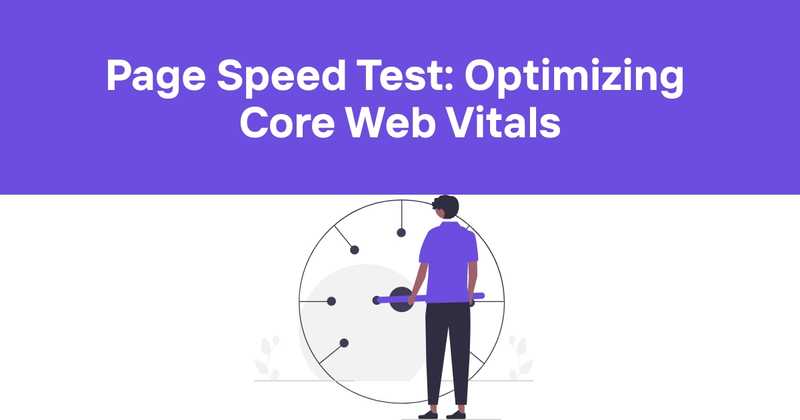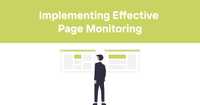Page Speed Test: Optimizing Core Web Vitals
Website speed matters. A lot. It impacts user experience, conversion rates, and even search engine rankings. But how do you actually measure page speed and figure out what to improve? That's where page speed test tools come in handy.
As a developer who's obsessed with optimizing web performance, I've tried just about every speed testing tool out there. In this article, I'll break down what page speed tests are all about, how to use them effectively, and my recommendations for the best tools to analyze your site speed.
Table of Contents
- What is a Page Speed Test?
- Why Page Speed Matters
- Key Page Speed Metrics
- How to Run a Page Speed Test
- Popular Page Speed Test Tools
- Interpreting Page Speed Test Results
- Common Page Speed Issues
- Tips to Improve Page Speed
- Mobile vs. Desktop Speed
- The Impact of CDNs on Page Speed
- Page Speed and SEO
- Monitoring Page Speed Over Time
- Page Speed Testing Best Practices
- Conclusion
What is a Page Speed Test?
A page speed test measures how quickly content loads and becomes interactive on a web page. It analyzes various aspects of page load time, including server response, resource loading, rendering, and more.
Think of it like a health checkup for your website. Just as a doctor runs tests to assess different aspects of your physical health, a page speed test examines multiple factors that contribute to your site's performance.
These tests typically provide:
- Overall speed scores
- Detailed timing breakdowns
- Performance metrics (more on these later)
- Recommendations for improvement
But here's the thing - there's no single, universal "page load time" metric. The loading process has multiple milestones, and different tools may focus on different aspects of performance.
Why Page Speed Matters
"But does anyone really care if my site loads in 2 seconds vs 3 seconds?"
Trust me, they do. And so do search engines.
Here's why page speed is crucial:
-
User experience: Slow sites frustrate users. Period. They'll bounce and likely never return.
-
Conversion rates: Faster sites convert better. Amazon found that a 100ms delay in load time decreased sales by 1%.
-
SEO: Google uses page speed as a ranking factor. Faster sites have an edge in search results.
-
Mobile performance: On mobile devices with potentially slower connections, every millisecond counts.
-
Competitive advantage: In a world of short attention spans, speed can set you apart from competitors.
Bottom line: Ignoring page speed is leaving money on the table and driving potential customers away.
Key Page Speed Metrics
Before we dive into testing tools, let's cover some critical metrics you'll encounter:
-
Time to First Byte (TTFB): How long it takes for the server to respond to the initial request.
-
First Contentful Paint (FCP): When the first content (text, image, etc.) appears on screen.
-
Largest Contentful Paint (LCP): When the largest content element becomes visible.
-
Time to Interactive (TTI): When the page becomes fully interactive.
-
Total Blocking Time (TBT): Sum of time periods between FCP and TTI where the main thread was blocked.
-
Cumulative Layout Shift (CLS): Measures visual stability and unexpected layout shifts.
-
Speed Index: How quickly content is visually displayed during page load.
Of these, Google emphasizes LCP, CLS, and First Input Delay (FID) as Core Web Vitals - key metrics for user experience.
How to Run a Page Speed Test
Running a basic speed test is straightforward:
- Choose a testing tool (we'll cover options soon)
- Enter your URL
- Select testing location and device type (if applicable)
- Run the test
- Review results and recommendations
But to get truly valuable insights:
- Test multiple pages, not just your homepage
- Run tests from different geographic locations
- Test on both mobile and desktop
- Perform multiple tests and look at average results
- Compare your site to competitors
Remember, a single test is just a snapshot. Regular testing helps you track improvements and catch performance regressions.
Popular Page Speed Test Tools
There are tons of speed testing tools out there. Here are some of the most widely used and respected options:
1. Google PageSpeed Insights
Google's own tool is a no-brainer starting point. It provides:
- Lab data (simulated tests)
- Field data (real-user metrics)
- Performance scores
- Detailed recommendations
PageSpeed Insights is free, easy to use, and directly reflects Google's performance priorities.
2. GTmetrix
GTmetrix offers more detailed analysis than PageSpeed Insights, including:
- Waterfall charts
- Video playback of page load
- Multiple test locations
- Historical data tracking (paid plans)
I find GTmetrix particularly useful for visualizing the load sequence and identifying bottlenecks.
3. WebPageTest
WebPageTest is the Swiss Army knife of speed testing tools. It provides incredibly granular data, including:
- Multi-step transactions
- Traceroutes
- Content blocking
- Comparison views
It's overkill for basic testing, but invaluable for deep performance analysis.
4. Pingdom
Pingdom offers a user-friendly interface and some unique features:
- Page size and request breakdowns
- Performance grades by category
- Uptime monitoring (paid plans)
I like Pingdom for quick tests and sharing results with non-technical team members.
5. Lighthouse (in Chrome DevTools)
Lighthouse is built into Chrome and offers:
- Performance, accessibility, SEO, and best practices audits
- Simulated throttling
- Opportunity sizing
It's great for developers who want to test during the development process.
Interpreting Page Speed Test Results
Ok, you've run some tests. Now what? Here's how to make sense of the data:
-
Look at the big picture: Don't obsess over a single metric. Consider overall scores and how they compare to industry benchmarks.
-
Prioritize Core Web Vitals: Focus on LCP, CLS, and FID (or TBT as a proxy) first.
-
Identify low-hanging fruit: Look for quick wins like image optimization or enabling compression.
-
Analyze the waterfall: Understanding the load sequence helps pinpoint bottlenecks.
-
Consider user impact: Weigh potential optimizations against their effect on real users.
-
Check for outliers: If one test shows significantly worse results, investigate potential temporary issues.
Remember, the goal isn't a perfect score - it's a fast, smooth user experience that supports your business objectives.
Common Page Speed Issues
Through countless tests, I've seen some issues crop up again and again:
-
Unoptimized images: Oversized, uncompressed images are speed killers.
-
Render-blocking resources: CSS and JavaScript that delay page rendering.
-
Excessive HTTP requests: Too many separate files being loaded.
-
Lack of browser caching: Not leveraging the browser's ability to store resources.
-
Unminified code: CSS, JavaScript, and HTML that haven't been compressed.
-
Slow server response time: Server-side performance issues.
-
Unoptimized fonts: Web fonts can significantly impact load times.
-
Excessive DOM size: Too many DOM elements slowing down rendering and interactions.
Tackling these common culprits often leads to substantial performance gains.
Tips to Improve Page Speed
Based on those common issues, here are some go-to optimization strategies:
-
Optimize images: Compress, resize, and use modern formats like WebP.
-
Minimize HTTP requests: Combine files, use CSS sprites, and leverage icon fonts.
-
Enable compression: Use Gzip or Brotli to compress text-based resources.
-
Leverage browser caching: Set appropriate cache headers for static resources.
-
Minify code: Remove unnecessary characters from HTML, CSS, and JavaScript.
-
Use a Content Delivery Network (CDN): Serve static content from geographically distributed servers.
-
Optimize CSS delivery: Inline critical CSS and defer non-critical styles.
-
Reduce server response time: Optimize database queries, use caching, upgrade hosting if needed.
-
Implement lazy loading: Defer loading of off-screen images and other non-critical resources.
-
Optimize web fonts: Use
font-display: swap, subset fonts, and consider system fonts.
Remember, the specific optimizations that will have the biggest impact depend on your individual site. Always test changes to ensure they actually improve performance.
Mobile vs. Desktop Speed
Mobile optimization deserves special attention. Why?
- Mobile traffic often exceeds desktop for many sites
- Mobile devices typically have less processing power
- Mobile connections can be slower and less stable
- Google uses mobile-first indexing for search rankings
When testing, pay close attention to mobile results. Common mobile-specific issues include:
- Unoptimized images
- Render-blocking JavaScript
- Excessive DOM size
- Touch delay
Strategies for mobile optimization:
- Use responsive images
- Implement AMP (Accelerated Mobile Pages) for content-heavy sites
- Minimize JavaScript execution
- Optimize tap targets for touch interfaces
Always test your mobile experience on real devices, not just emulators.
The Impact of CDNs on Page Speed
Content Delivery Networks (CDNs) can dramatically improve page speed, especially for users geographically distant from your origin server.
CDNs work by:
- Distributing your content across a network of servers
- Serving resources from the nearest server to each user
- Offloading traffic from your origin server
Benefits of using a CDN:
- Reduced latency
- Improved availability and redundancy
- DDoS protection
- SSL/TLS acceleration
Popular CDN providers include Cloudflare, Akamai, and Amazon CloudFront. Many offer free tiers to get started.
When implementing a CDN, be sure to:
- Configure proper cache headers
- Set up SSL correctly
- Use CDN features like image optimization and minification
Page Speed and SEO
Let's talk more about how page speed impacts search engine optimization (SEO).
Google has explicitly stated that page speed is a ranking factor for both desktop and mobile searches. It's part of the broader "Page Experience" signals that influence rankings.
Key points:
- Core Web Vitals are now ranking signals
- Mobile page speed is particularly important due to mobile-first indexing
- Faster pages may get crawled more frequently
- User engagement metrics (which speed influences) also impact SEO
But don't panic if you don't have perfect scores. Content relevance and quality still outweigh pure speed. Focus on providing a good user experience, which includes - but isn't limited to - fast load times.
Monitoring Page Speed Over Time
One-off speed tests are useful, but monitoring performance over time is crucial. Why?
- Catch performance regressions quickly
- Track the impact of optimizations
- Identify patterns (e.g., slowdowns during high-traffic periods)
- Benchmark against competitors
Tools for ongoing monitoring:
-
Google Search Console: Provides Core Web Vitals data based on real user metrics.
-
Chrome User Experience Report: Access real-world performance data for your site.
-
Synthetic monitoring tools: Services like Pingdom or New Relic that regularly run tests from various locations.
-
Real User Monitoring (RUM): Collect performance data from actual site visitors.
Set up alerts for significant changes in key metrics to stay on top of performance issues.
Page Speed Testing Best Practices
To wrap up, here are some best practices to keep in mind:
-
Test regularly: Schedule automated tests and review results frequently.
-
Use multiple tools: Different tools provide different insights. Don't rely on just one.
-
Test critical user flows: Go beyond just testing your homepage.
-
Compare to competitors: Benchmark your performance against similar sites in your industry.
-
Consider context: A 0.2s improvement might be huge for an e-commerce site, less impactful for a blog.
-
Test in incognito mode: Avoid skewed results from browser extensions or cached resources.
-
Verify in production: Staging environments may not accurately reflect real-world performance.
-
Communicate with your team: Share results and get buy-in for performance initiatives.
-
Set performance budgets: Establish speed targets and enforce them in your development process.
-
Keep learning: Web performance is an evolving field. Stay updated on best practices and new technologies.
Conclusion
Page speed isn't just a technical metric - it's a key factor in user experience, conversion rates, and search engine rankings. Regular testing and optimization should be an ongoing part of your web development and maintenance process.
Remember, the goal isn't to achieve perfect scores on every metric. It's to provide the best possible experience for your users while balancing other business needs.
For those looking to simplify their performance monitoring process, Odown.com offers comprehensive website and API monitoring tools. Beyond just uptime checks, Odown provides detailed performance metrics, allowing you to track your page speed over time. Their SSL certificate monitoring feature ensures you never miss a renewal, preventing potential security warnings that could drive visitors away.
Additionally, Odown's public status pages allow you to transparently communicate any performance issues or scheduled maintenance to your users, building trust and reducing support inquiries during downtime.
By combining regular page speed testing with ongoing monitoring through a tool like Odown, you can ensure your site stays fast, secure, and reliable for your users.



